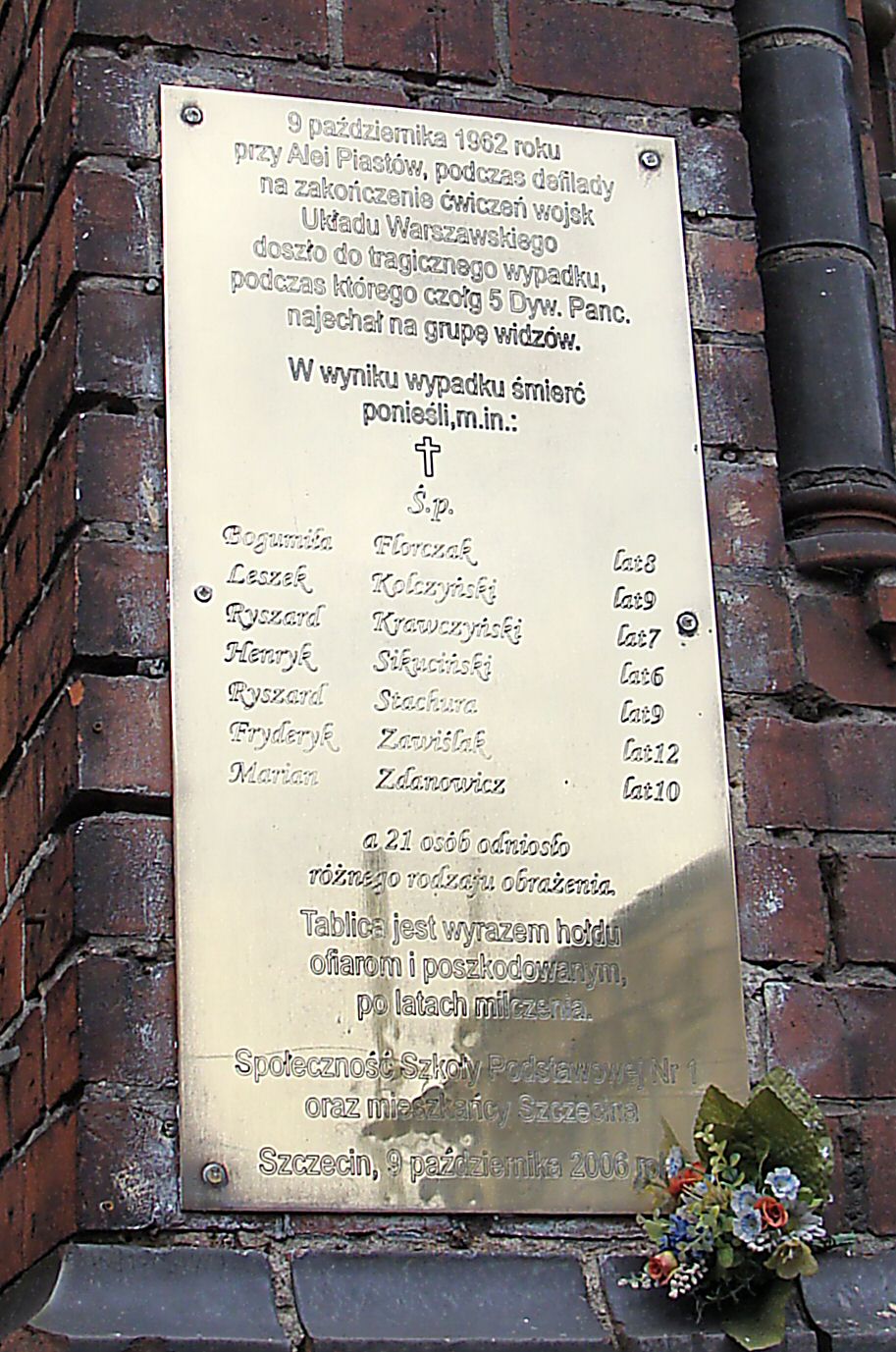
9/10/1962 - Czołgi T-54 przejeżdżają ulicami Szczecina / T-54 tanks on the Szczecin parade

Tablica pamiątkowa / Commemorative Plaque
POLSKA WERSJA
Wypadek na Defiladzie Wojsk Układu Warszawskiego w Szczecinie miał miejsce 9 października 1962 r. 7 osób zginęło, a 43 odniosło obrażenia, gdy czołg, nad którym kierowca utracił panowanie, wjechał w tłum widzów.
Defilada była pokazem potęgi wojsk sojuszniczych oraz najnowszego sprzętu na ich wyposażeniu. Podczas defilady zaprezentowano między innymi: czołgi, transportery opancerzone, wyrzutnie rakiet, haubice. Obecni byli przedstawiciele polskich władz państwowych Władysław Gomułka oraz marszałek ZSRR Andriej Grieczko. Defiladę obserwowały tłumy mieszkańców miasta, ustawionych wzdłuż trasy przejazdu wojsk biegnącej między innymi przez Plac Lenina i Aleję Piastów. Wśród widzów znajdowali się także uczniowie szczecińskich szkół wysłani na defiladę, by witać żołnierzy sprzymierzonych armii kwiatami.
Trasa przejazdu wozów opancerzonych i czołgów została źle zabezpieczona, a obserwujący defiladę mieszkańcy miasta zeszli z chodników na jezdnię, zbliżając się do przejeżdżających pojazdów. Do wypadku doszło podczas przejazdu ostatniego polskiego czołgu T-54A (nr taktyczny 0165) z 23. Pułku Czołgów Średnich ze Słubic (5. Dywizja Pancerna). Kierowca stracił panowanie nad jadącą z prędkością około 25 km/godz. maszyną i wjechał w tłum wiwatujących dzieci, w wyniku czego śmierć poniosło siedmioro z nich w wieku od 6 do 12 lat. Ciężko rannych zostało 21 osób, w tym również dzieci (wiele pozostało inwalidami), a kolejne 22 osoby zostały poturbowane w wyniku paniki, jaka wybuchła wśród osób stojących w bezpośredniej bliskości wypadku. Świadków zdarzenia było co najmniej kilkuset.
Ofiarami śmiertelnymi, według ustaleń IPN były:
- Ryszard Stachura (lat 9)
- Bogumiła Florczak (lat 8)
- Ryszard Krawczyński (lat 7)
- Marian Zdanowicz (lat 10)
- Fryderyk Zawiślak (lat 12)
- Henryk Sikuciński (lat 6)
- Leszek Kolczyński (lat 9)
Pamięć o zdarzeniu starano się wymazać dla zachowania jak najlepszego wizerunku sprzymierzonych wojsk. O wypadku poinformował jedynie w lakonicznym komunikacie „Głos Szczeciński”. Informacje o wypadku wymazano z dokumentów szpitalnych ofiar. Świadkom zdarzenia nakazywano milczenie, grożąc odpowiedzialnością za złamanie tajemnicy wojskowej, a samo śledztwo w sprawie wypadku umorzono, nie stwierdzając uchybień w organizacji defilady.
ENGLISH VERSION
The Fall of 1962 was a hectic time, as due to the growing Cuban Missile Crisis, the world was standing on the brink of war between the Eastern Bloc and the Western Bloc. In such circumstances, planners of the Warsaw Pact decided to organize huge military exercises, located in northwest Poland, in the area of Szczecin. The exercises were observed by Marshal of the Soviet Union Andrei Grechko as well as several Polish officials, including Władysław Gomułka. The parade in Szczecin was to be the finale of the maneuvers.
On October 9, 1962, the main streets in the center of Szczecin were closed to traffic. Inhabitants of the city crowded the sidewalks, curious to see tanks and equipment of the three allied armies: the Polish People's Army, the Soviet Army, and the Nationale Volksarmee. Tens of thousands of people, including children, gathered along Szczecin’s main arteries of Aleja Wojska Polskiego and Aleja Piastów. Everybody was anticipating the widely promoted event, and schoolchildren were told to describe the parade as their homework. Students of all schools were allowed to go home early, so that they could see the parade. In most cases curious children were standing on the curbs as close to the tanks and other weapons as possible.
It is not known why a T-54 tank (marked with number 0165) of the Polish Army ran into a group of children, standing either on the sidewalk by the Aleja Piastow street, or on the street itself (sources vary on this matter). All documents describing this incident were destroyed in March 1982 and all information about the tragedy was blanked out. It is possible that the tank, which was the last one in line, drove too fast or skidded on the slippery road. The tank, weighing 36 tons, was traveling at a speed of some 30 km/h.
Altogether, seven children died. Four of them were students of Szczecin’s Elementary number 1; in 2006 a plaque commemorating the tragedy was placed by the entrance to the school. The children who died were aged from 6 to 12 years.
The shocked inhabitants of Szczecin never had a chance to find out more about the incident. The communist authorities expunged any information about the event and it was not reported in the Polish mass media. A local daily Glos Szczecinski placed a small notice on October 10 telling readers that seven children died during a parade. Families of the dead children were told to not discuss the topic with anyone.
Hundreds of witnesses were later called by the military prosecutor’s office. All were told that the incident was classified and revealing it would mean imprisonment. At the same time, the trial of the tank’s crew was dismissed, as, according to the military court, the tank had not crossed the curb. All hospital documents connected with the event were confiscated by the military, never to be returned. To this day, the events surrounding the 1962 Szczecin parade are largely unknown elsewhere in Poland.
Źródło / Source: wikipedia.com